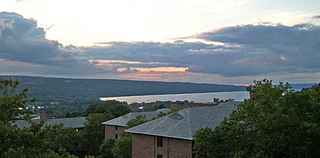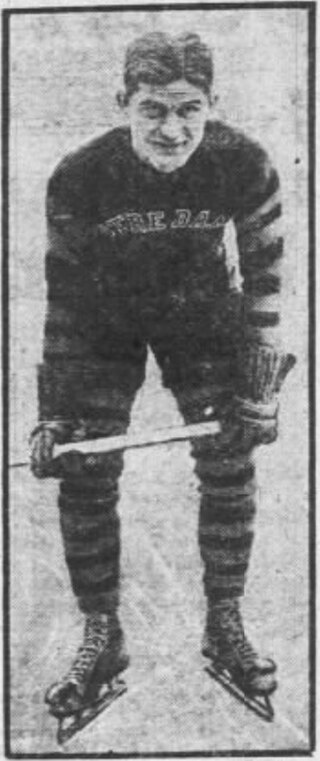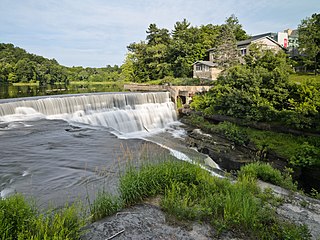
Beebe Lake /bibi/ is a reservoir in Ithaca, New York, located on the campus of Cornell University. [1]

Beebe Lake /bibi/ is a reservoir in Ithaca, New York, located on the campus of Cornell University. [1]
Beebe Lake was once a forested swamp. [2] A pond was formed when Ezra Cornell constructed a dam on Fall Creek in 1838, above Triphammer Falls, to provide power to the mills owned by Jeremiah S. Beebe. [3] Cornell constructed a tunnel 200 feet long and 15 feet high to channel the water, raising the water level 18 feet. [2] [4] In 1898, the dam was raised an additional ten feet, turning the pond into a proper lake. [2]
The lake is dredged approximately once a decade in order to prevent it from returning to its original wetland state. [3]
Beebe Lake became a major local destination for winter recreation starting in the 1890s. [5] The space was maintained by the Cornell Athletic Association but open to the public for ice skating. [5] Ithaca Street Railway trolleys would announce that the ice was open for skating by displaying a white banner with red ball. Trolley passengers with skates rode for half price. [5] In the Spring when the ice melted, sometimes local children would break of chunks of ice with poles, and ride the ice rafts downstream. [5]
A toboggan slide was a popular attraction on Beebe Lake for the first half of the 20th Century. The first one was erected around 1900 and made of wood; it was replaced by a steel slide in the 1920s. [5] Although dangerous and costly to operate, it remained enormously popular, until Cornell removed the slide in 1949. [5]
In the early 20th Century, Cornell fraternities held ice castle building competitions, creating intricate structures with decorated pillars. [5]
The lake was also Cornell's primary venue for ice hockey matches during the first decades of the sport. [5] However, the ice would sometimes melt just before a scheduled contest, making it an unreliable venue. In 1957 Lynah Rink was constructed, freeing the hockey team from the unpredictability of the climate. [5]
In recent decades, the lake remains a popular spot for paddling by organizations such as the Cornell Outing Club. [6]

Cayuga Lake (,,) is the longest of central New York's glacial Finger Lakes, and is the second largest in surface area and second largest in volume. It is just under 39 miles (63 km) long. Its average width is 1.7 miles (2.8 km), and it is 3.5 mi wide (5.6 km) at its widest point, near Aurora. It is approximately 435 ft deep (133 m) at its deepest point, and has over 95 miles (153 km) of shoreline.

Ithaca is a city and the county seat of Tompkins County, New York, United States. Situated on the southern shore of Cayuga Lake in the Finger Lakes region of New York, Ithaca is the largest community in the Ithaca metropolitan statistical area. It is named after the Greek island of Ithaca.

Ice skating is the self-propulsion and gliding of a person across an ice surface, using metal-bladed ice skates. People skate for various reasons, including recreation (fun), exercise, competitive sports, and commuting. Ice skating may be performed on naturally frozen bodies of water, such as ponds, lakes, canals, and rivers, and on human-made ice surfaces both indoors and outdoors.

Winter sports or winter activities are competitive sports or non-competitive recreational activities which are played on snow or ice. Most are variations of skiing, ice skating and sledding. Traditionally, such games were only played in cold areas during winter, but artificial snow and artificial ice allow more flexibility. Playing areas and fields consist of either snow or ice.
Cayuga Heights is a village in Tompkins County, New York, United States, and an upscale suburb of Ithaca. The population was 4,114 at the 2020 census.

Ezra Cornell was an American businessman, politician, and philanthropist. He was the founder of Western Union and a co-founder of Cornell University. He also served as President of the New York Agriculture Society and as a New York State Senator.

An ice rink is a frozen body of water and/or an artificial sheet of ice created using hardened chemicals where people can ice skate or play winter sports. Ice rinks are also used for exhibitions, contests and ice shows. The growth and increasing popularity of ice skating during the 1800s marked a rise in the deliberate construction of ice rinks in numerous areas of the world.

Lynah Rink is a 4,267-seat hockey arena at Cornell University in Ithaca, New York, that opened in 1957. Named after James Lynah, Class of 1905, who was the director of Cornell athletics from 1935 to 1943, it is home to the Big Red men's and women's ice hockey teams. Lynah has been home to hockey greats such as Ken Dryden, Joe Nieuwendyk, Matt Moulson, Digit Murphy, and Olympic Gold Medalists Rebecca Johnston and Brianne Jenner.

Cornelliana is anything related to Cornell University, an Ivy League university founded in 1865 in Ithaca, New York. The university has a considerable number of traditions, legends, and lore unique to the university that have developed over its existence, which spans over 150 years.

The Cornell Botanic Gardens is a botanical garden located adjacent to the Cornell University campus in Ithaca, New York. The Botanic Gardens proper consist of 25 acres (10 ha) of botanical gardens and 150 acres (61 ha) of the F. R. Newman Arboretum. The greater Botanic Gardens includes 40 different nature areas around Cornell and Ithaca, covering 4,300 acres (1,700 ha).

The Cornell–Harvard hockey rivalry is a men's ice hockey sports rivalry between the Big Red of Cornell University and Crimson of Harvard University dating back to 1910.

Central Campus is the primary academic and administrative section of Cornell University's Ithaca, New York campus. It is bounded by Libe Slope on the west, Fall Creek on the north, and Cascadilla Creek on the South.
Palgrave Pond is a reservoir just northwest of the community of Palgrave in the Town of Caledon, Regional Municipality of Peel in the Greater Toronto Area of southern Ontario, Canada. It is adjacent to Ontario Highway 50 and was formed by the damming of the main branch of the Humber River, originally to create a mill pond. Each winter, the surface of the pond is transformed into a community skating rink available for recreational use. The rinks are created by local volunteer, Ken Hunt, and have appeared on the Mill Pond each winter since December 2000.

Arthur Benjamin "Bud" Boeringer was an American football center at the University of Notre Dame. Minnesota native Boeringer was a consensus All-American in 1926. After college, he coached both football and hockey at the collegiate level including being a head coach of the University of Detroit and Cornell University ice hockey teams.

The 1906–07 Cornell Big Red men's ice hockey season was the 6th season of play for the program.

Triphammer Falls is a 55-foot (17 m) waterfall on Fall Creek in Ithaca, New York, located within the campus of Cornell University. The waterfall existed naturally but was altered substantially in order to construct a dam in the 19th century, leading to the formation of Beebe Lake. The dam is capable of regulating the water flow between 12–4,700 cubic feet (0.34–133.09 m3) per second. In 1997, a pedestrian bridge was built over Triphammer Falls to connect Central and North Campus.

The 1935–36 Cornell Big Red men's ice hockey season was the 29th season of play for the program. The teams was coached by Nick Bawlf in his 14th season.

The 1939–40 Cornell Big Red men's ice hockey season was the 33rd season of play for the program. The teams were coached by Nick Bawlf in his 18th season.

The 1941–42 Cornell Big Red men's ice hockey season was the 35th season of play for the program. The teams was coached by Nick Bawlf in his 20th season.

The Cornell Ann S. Bowers College of Computing and Information Science, known as Cornell Bowers CIS for short, is an entity within Cornell University. The college comprises the Department of Computer Science, the Department of Information Science, and the Department of Statistics and Data Science. However, as Cornell computer science professor David Gries has explained, "essentially it's a college without students," with students instead being admitted to, and coming from, three of Cornell's regular undergraduate schools: the College of Engineering, the College of Arts and Sciences, and the College of Agriculture and Life Sciences. A variety of degree programs are offered through the college, depending upon the department within the college and the originating college the student is in; the degrees granted include Bachelor of Arts and Bachelor of Science; Master of Science, Master of Engineering, and Master of Professional Studies; and PhD. In addition, students from any of Cornell's seven different undergraduate schools can minor in computer science or information science.